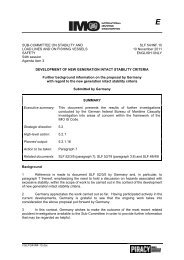Examination of the intact stability and the seakeeping behaviour
Examination of the intact stability and the seakeeping behaviour
Examination of the intact stability and the seakeeping behaviour
Create successful ePaper yourself
Turn your PDF publications into a flip-book with our unique Google optimized e-Paper software.
5 Evaluation<br />
Fur<strong>the</strong>rmore <strong>the</strong> increase <strong>of</strong> <strong>the</strong> ship's speed always reduces <strong>the</strong> roll motion. But at rst <strong>the</strong><br />
vessel has to be able to signicantly increase <strong>the</strong> speed, which is not self-evident due to <strong>the</strong> high<br />
wave forces slowing <strong>the</strong> ship with each wave. On <strong>the</strong> o<strong>the</strong>r h<strong>and</strong> a higher ship's speed in heavy<br />
seaway causes high slamming loads on <strong>the</strong> ship's bow structure, when heading into <strong>the</strong> waves.<br />
This eect may cause severe damages on <strong>the</strong> structure, especially for vessels with a large bow<br />
are. At last with a higher speed <strong>and</strong> heading into <strong>the</strong> waves, <strong>the</strong> vessel may be endangered <strong>of</strong><br />
encountering a critical 2:1 resonance. Therefore <strong>the</strong> augmentation <strong>of</strong> <strong>the</strong> ship's speed to improve<br />
<strong>the</strong> roll damping is suitable to only a limited number <strong>of</strong> cases. The inuence <strong>of</strong> ship's speed is<br />
also determined for Vessel No. 13. The associated graph in appendix C.1 shows that <strong>the</strong> ship's<br />
speed has not a signicant inuence, too. For this analysis, <strong>the</strong> vessel in ballast arrival condition<br />
encounters again <strong>the</strong> seaway <strong>of</strong> accident situation 2.<br />
At last <strong>the</strong> integration <strong>of</strong> a roll damping tank has <strong>the</strong> advantage, that it also functions with<br />
zero ship's speed. But it reduces <strong>the</strong> ship's payload due to <strong>the</strong> used space for <strong>the</strong> tank <strong>and</strong><br />
reduces <strong>the</strong> <strong>intact</strong> <strong>stability</strong> due to <strong>the</strong> free surface <strong>of</strong> <strong>the</strong> tank.<br />
5.3.3 Lines <strong>of</strong> <strong>the</strong> ship<br />
The design <strong>of</strong> <strong>the</strong> lines <strong>of</strong> <strong>the</strong> ship has a strong inuence on <strong>the</strong> <strong>seakeeping</strong> behavior. As mentioned<br />
before, <strong>the</strong> shape <strong>of</strong> <strong>the</strong> frames or ra<strong>the</strong>r <strong>the</strong> shape <strong>of</strong> <strong>the</strong> bow are in combination with<br />
<strong>the</strong> wide transom, governs <strong>the</strong> induced rolling moments. Already during <strong>the</strong> very early design<br />
phase, <strong>the</strong> following compromise has to be determined. On one h<strong>and</strong> <strong>the</strong> vessel is intended to<br />
carry as much cargo as possible which results in aring hull forms. On <strong>the</strong> o<strong>the</strong>r h<strong>and</strong> this <strong>of</strong>ten<br />
contradicts with <strong>the</strong> dem<strong>and</strong> <strong>of</strong> a good <strong>seakeeping</strong> behavior.<br />
5.3.4 O<strong>the</strong>r<br />
The operating behavior <strong>of</strong> <strong>the</strong> crew has also an inuence. Besides <strong>the</strong> increase <strong>of</strong> <strong>the</strong> ship's speed,<br />
<strong>the</strong> risk <strong>of</strong> accident can be reduced by placing <strong>the</strong> vessel parallel to <strong>the</strong> main wave direction at<br />
zero speed. In beam sea a lot <strong>of</strong> <strong>the</strong> wave energy induced into <strong>the</strong> ship is transformed into a<br />
drift motion in beam direction. Therefore <strong>the</strong> roll motions <strong>of</strong> <strong>the</strong> vessel are reduced. A problem<br />
in this position can be, that <strong>the</strong> ship's stern turns into <strong>the</strong> waves due to <strong>the</strong> poor course keeping<br />
ability at zero speed. When this happens to container vessels with <strong>the</strong>ir wide <strong>and</strong> at transom,<br />
<strong>the</strong> stern experiences <strong>of</strong>ten high slamming loads. Fur<strong>the</strong>rmore drifting in beam sea is obviously<br />
not advisable inshore.<br />
46

















